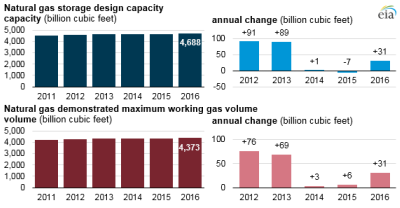US natgas storage capacity increased slightly in 2016
For the past three years, underground natural gas storage capacity in the Lower 48 states has changed by relatively small increments compared to the changes in 2012 and 2013. No new storage facilities have entered service since 2013, so recent annual changes in both storage design capacities and demonstrated maximum working gas volumes reflect the aggregate effect of small changes at existing facilities.
 |
| Courtesy of EIA. |
The relatively small change in natural gas storage capacity over the past three years is likely a reflection of long-term trends, such as higher levels of natural gas production, the proximity of production to consuming markets in the Northeast and Midwest, and the lower price premium for natural gas during the winter. These trends may reduce reliance on storage as a source of supply during periods of elevated demand, such as during cold winter months.
EIA has published updated estimates of storage capacity based on data for the end of November, which is approximately when storage levels have reached their highest points for the year. EIA uses two distinct measures of natural gas storage capacity: design capacity and demonstrated working natural gas volume.
Design capacity is the sum of the 385 active storage fields’ working gas design capacity, as of November 2016, as reported in EIA’s Underground Natural Gas Working Storage Capacity. Design capacity is based on the physical characteristics of the reservoir, installed equipment, and operating procedures particular to the site that are often certified by federal or state regulators. Design capacity increased slightly, growing 0.7%, from 4,658 Bcf in November 2015 to 4,688 Bcf in November 2016. This increase resulted from a combination of expansions at existing facilities, reclassifications from base gas to working gas, and the restoration of an inactive facility to service.
Demonstrated maximum working gas volume is the sum of peak volumes reported by the 385 active storage facilities in the Lower 48 states, regardless of when the individual field-level peaks occurred over the five-year (60-month) reporting period ending November 2016. In the graphic below, this measure is compared to the five-year period ending November 2015. In the Lower 48 states, the demonstrated maximum working gas volume grew by 0.7%, from 4,342 Bcf in 2015 to 4,373 Bcf in 2016.
Demonstrated maximum working gas volumes can be affected by short-term circumstances. For example, the 2016 injection season started with very high levels largely because of the mild winter of 2015–16. These injections led to all-time high storage levels in November, at the beginning of the most recent withdrawal season. As a result, many storage facilities reached new demonstrated maximums in 2016.

- ExxonMobil halts 1-Bft3d blue hydrogen project in Texas
- Aramco and Yokogawa commission multiple autonomous control AI agents at Fadhili gas plant
- Ukraine will resume gas imports via Transbalkan route in November
- Mitsubishi to inject $260 MM into Brunei LNG project
- Freeport LNG (U.S.) on track to take in more natgas on Thursday after unit outage



Comments